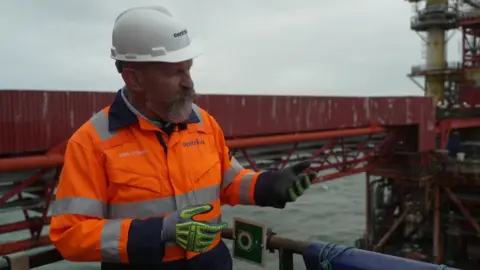In recent developments regarding the UK’s energy sector, Chris O’Shea, the chief executive of Centrica, has issued significant warnings regarding the future of the Rough gas storage facility, the UK’s largest gas storage site. During an interview on BBC One’s “Sunday with Laura Kuenssberg,” he stated that without government intervention, the facility may face permanent closure. This warning underlines concerns about energy pricing, which Centrica believes will lead to financial losses amounting to £100 million this year if left unaddressed.
The Rough facility, located off the coast of East Yorkshire, holds a vital position in the UK’s energy infrastructure, accounting for nearly half of the nation’s gas storage capacity. Closed since 2017, it was partially reopened in October 2022 following the energy crisis exacerbated by Russia’s invasion of Ukraine. Currently, Centrica seeks to invest £2 billion into this facility to expand its capacity, including the ability to store hydrogen, which could be crucial for supporting the UK’s transition to renewable energy sources.
The UK government has responded by emphasizing that the future of Rough is a commercial matter for Centrica, while remaining open to discussions about potential support mechanisms that would facilitate the required investments. O’Shea explained that Centrica is advocating for a “cap and floor” pricing mechanism, which would provide a safety net against volatile energy prices. This critical measure would ensure that Centrica’s revenues are supplemented if prices dip below a certain threshold, while also capping revenues if prices surge excessively.
Emphasizing the wider economic impact of securing investment in Rough, O’Shea noted that such an initiative could significantly contribute to job creation in construction and safeguard skilled jobs in offshore operations. He pointed out that the UK currently has only 12 days of gas storage, and Rough is responsible for half of this capacity. Hence, if Rough were to close, the UK’s storage resilience would be reduced to a mere six days. Conversely, investing in Rough could increase capacity significantly to about 25 or 30 days.
A spokesperson from the Department for Energy Security and Net Zero indicated that while the commercial future of Rough lies in Centrica’s hands, they are open to discussions that provide value for taxpayers. This affirms the government’s cautious stance regarding financial support for energy infrastructure.
Moreover, O’Shea weighed in on the broader context of energy pricing in the UK. He acknowledged that the current pricing mechanisms serve as a barrier to reducing electricity costs, even as new renewable energy developments are introduced. Despite the importance of decarbonisation and its economic potential for the UK, O’Shea stated that today’s electricity prices remain consistent with those offered to new renewable ventures, thereby failing to lower overall costs for consumers.
In addressing the ambitious government target for clean energy by 2030, O’Shea described the goals as both challenging and necessary. His comments underline a dual focus on achieving energy goals while also managing the economic implications of energy pricing.
On another note, O’Shea’s leadership at Centrica has not come without scrutiny, particularly pertaining to his remuneration. He previously remarked that his £4.5 million salary was “impossible to justify,” highlighting the tension between executive compensation and shareholder expectations. Recently, nearly 40% of Centrica’s shareholders opposed the company’s latest pay plans, reflecting discontent among investors regarding executive salaries.
In summary, the future of the Rough gas storage facility is intertwined with government policies and market conditions. Centrica’s request for a supportive pricing mechanism highlights the complex interplay between energy security, market dynamics, and the transition to a low-carbon economy. The decisions surrounding Rough not only affect energy resilience but also the broader economic landscape, emphasizing the importance of strategic investments in the UK’s energy infrastructure.



